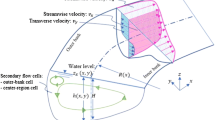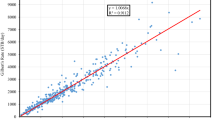Abstract
In this study, non-Darcian flow to a larger-diameter partially penetrating well in a confined aquifer was investigated. The flow in the horizontal direction was assumed to be non-Darcian and described by the Izbash equation, and the flow in the vertical direction was assumed to be Darcian. A linearization procedure was used to approximate the nonlinear governing equation. The Laplace transform associated with the finite cosine Fourier transform was used to solve such non-Darcian flow model. Both the drawdowns inside the well and in the aquifer were analyzed under different conditions. The results indicated that the drawdowns inside the well were generally the same at early times under different conditions, and the features of the drawdowns inside the well at late times were similar to those of the drawdowns in the aquifer. The drawdown in the aquifer for the non-Darcian flow case was larger at early times and smaller at late times than their counterparts of Darcian flow case. The drawdowns for a partially penetrating well were the same as those of a fully penetrating well at early times, and were larger than those for a fully penetrating well at late times. A longer well screen resulted in a smaller drawdown in the aquifer at late times. A larger power index n in the Izbash equation resulted in a larger drawdown in the aquifer at early times and led to a smaller drawdown in the aquifer at late times. A larger well radius led to a smaller drawdown at early times, but it had little impact on the drawdown at late times. The wellbore storage effect disappears earlier when n is larger.







Similar content being viewed by others
References
Barker JA, Herbert R (1982) Pumping tests in patchy aquifer. Ground Water 20(2):150–155
Bordier C, Zimmer D (2000) Drainage equations and non-Darcian modeling in coarse porous media or geosynthetic materials. J Hydrol 228(3–4):174–187
Boulton NS (1954) The drawdown of the water table under nonsteady conditions near a pumped well in an unconfined formation. Proc Inst Civil Eng 3(2):564–579
Cimen M (2001) A simple solution for drawdown calculation in a large-diameter well. Ground Water 39(1):144–147
Ewing RE, Lazarov RD, Lyons SL, Papavassiliou DV, Pasciak J, Qin G (1999) Numerical well model for non-Darcy flow through isotropic porous media. Comp Geosci 3(3–4):185–204
Fenske PR (1977) Radial flow with discharging-well and observation-well storage. J Hydrol 32(1–2):87–96
Hantush MS (1959) Nonsteady flow to flow wells in leaky aquifers. J Geophys Res 64(8):1043–1052
Hantush MS, Jacob CE (1955) Non-steady radial flow in an infinite leaky aquifer. Am Geophys Union Trans 36(1):95–100
Kolditz O (2001) Non-linear flow in fractured rock. Int J Numer Method Heat Fluid Flow 11(5–6):547–575
Lai RY, Su CW (1974) Nonsteady flow to a large well in a leaky aquifer. J Hydrol 22(3–4):333–345
Li PY, Qian H, Wu JH (2014) Determining the optimal pumping duration of transient pumping test for estimating hydraulic properties of leaky aquifers using global curve-fitting method: a simulation approach. Environ Earth Sci 71(1):293–299
Mathias S, Butler A, Zhan HB (2008) Approximate solutions for Forchheimer flow to a well. J Hydraul Eng 134(9):1318–1325
Mishra PK, Vesselinov VV, Neuman SP (2012) Radial flow to a partially penetrating well with storage in an anisotropic confined aquifer. J Hydrol 448–449(2):255–259
Moutsopoulos KN, Papaspyros NE, Tsihrintzis VA (2009) Experimental investigation of inertial flow processes in porous media. J Hydrol 374(3–4):242–254
Neuman SP, Witherspoon PA (1969) Applicability of current theories of flow in leaky aquifers. Water Resour Res 5(4):817–829
Özisik MN (1989) Boundary value problems of heat conduction. Dover, New York
Papadopulos IS, Cooper HH (1967) Drawdown in a well of large diameter. Water Resour Res 3(1):241–244
Patel SC, Mishra GC (1983) Analysis of flow to a large-diameter well discrete kernel approach. Ground Water 21(5):573–576
Salcedo ER, Vicenta EM, Garrido HS (2013) Groundwater optimization model for sustainable management of the Valley of Puebla Aquifer, Mexico. Environ Earth Sci 70(1):337–351
Sen Z (1982) Type curves for large-diameter wells near barriers. Ground Water 20(3):274–277
Sen Z (1987) Non-Darcian flow in fractured rocks with a linear flow pattern. J Hydrol 92(1–2):43–57
Sen Z (1989) Nonlinear flow toward wells. J Hydrol 115(2):193–209
Sen Z (1990) Nonlinear radial flow in confined aquifers toward large-diameter wells. Water Resour Res 26(5):1103–1109
Shu LC, Deng MJ, Wang XH (2013) Evaluation of unconfined aquifer parameters from flow to partially penetrating wells in Tailan River basin, China. Environ Earth Sci 69(3):799–809
Sushil KS (2006) Simplified kernel method for flow to larger diameter wells. J Irrig Drain Eng ASCE 132(1):77–79
Theis CV (1935) The relation between the lowering of the piezometric surface and the rate and duration of discharge of a well using groundwater storage. Am Geophys Union Trans 16:519–524
Wang XJ, Xie ZH, Zhou X, Shao JL (2005) Simulation of artificial injection with large-diameter wells in the western outskirt of Beijing. Hydrogeol Eng Geol 32(1):71–74
Wang JX, Feng B, Yu HP, Guo TP, Yang GY, Tang JW (2013) Numerical study of dewatering in a large deep foundation on pit. Environ Earth Sci 69(3):863–872
Wen Z, Huang GH, Zhan HB (2008a) An analytical solution for non-Darcian flow in a confined aquifer using the power law function. Adv Water Res 31(1):44–55
Wen Z, Huang GH, Zhan HB, Li J (2008b) Two-region non-Darcian flow toward a well in a confined aquifer. Adv Water Res 31(5):818–827
Wen Z, Huang GH, Zhan HB (2009) A numerical solution for non-Darcian flow to a well in a confined aquifer using the power law function. J Hydrol 364(1–2):99–106
Wen Z, Liu K, Chen XL (2013) Approximate analytical solution for non-Darcian flow toward a partially penetrating well in a confined aquifer. J Hydrol 498:124–131
Yeh HD, Chang YC (2013) Recent advances in modeling of well hydraulics. Adv Water Resour 51:27–51
Acknowledgments
This research was partially supported by the National Natural Science Foundation of China (Grant Numbers: 41002082, 41372253), the National Basic Research Program of China (Grant Number: 2010CB428802), and the Special Fund for Basic Scientific Research of Central Colleges, China University of Geosciences (Wuhan) (Grant Numbers: CUG140503, CUG120113).
Author information
Authors and Affiliations
Corresponding author
Appendix: Derivation of the analytical solution in the Laplace domain
Appendix: Derivation of the analytical solution in the Laplace domain
Applying Laplace transform to Eq. (12) with considering the initial condition Eq. (2), one can obtain
in which p is the Laplace variable, over bar means the variable in Laplace domain. After using the finite cosine Fourier transform to deal with the second-order derivative of z, it can be expressed as:
The over ^sign means the variable in Fourier domain. The vertical boundary equations Eqs. (4) and (5) can be rewritten after the Laplace transform as:
Substituting Eqs. (19) and (20) to (18), one has
With the finite cosine Fourier transform, Eq. (17) can be changed to the following equation after some simplifications:
Eq. (22) is a Bessel equation, whose general solution can be expressed as:
in which \(\delta = \frac{{nK_{\text{z}} N^{2} \pi^{2} + B^{2} npS_{\text{s}} }}{{K_{\text{r}} B^{2} }}\left( {\frac{Q}{2\pi B}} \right)^{n - 1}\), I v(x) and K v(x) are the first and second kinds of modified Bessel functions with order v, respectively. C 1 and C 2 are constants, which depend on the boundary conditions. The radial boundary conditions Eqs. (3) and (6) can be changed to
and after using the Laplace transform and the finite cosine Fourier transform, one has
It should be pointed out that the linearization procedure has also been used in Eq. (25). With the consideration of Eq. (24) and the properties of the Bessel functions, one has C 1 = 0. Then, the solution of Eq. (23) can be rewritten as:
With Eqs. (25) and (26), one can obtain C 2 as:
It should be pointed out that the following properties of the second kind of modified Bessel functions have been used to obtain C 2: xdK v (x)/dx + vK v (x) = −xK v−1(x), K v (x) = K −v (x), \(K_{v} (x) \approx \frac{\varGamma (v)}{2}\left( \frac{x}{2} \right)^{ - v} ,\quad v > 0,x \to 0\). Therefore, the solution in Laplace–Fourier domain can be expressed as:
With inverse Fourier transform, one can obtain the solution in Laplace domain finally:
Rights and permissions
About this article
Cite this article
Wen, Z., Liu, K. & Zhan, H. Non-Darcian flow toward a larger-diameter partially penetrating well in a confined aquifer. Environ Earth Sci 72, 4617–4625 (2014). https://doi.org/10.1007/s12665-014-3359-6
Received:
Accepted:
Published:
Issue Date:
DOI: https://doi.org/10.1007/s12665-014-3359-6




